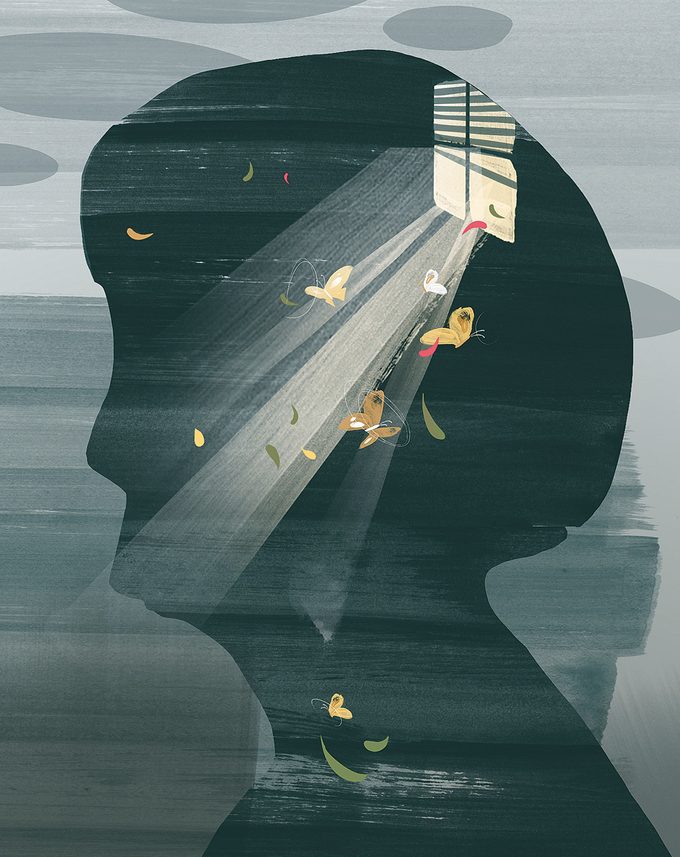Dementia Breakthroughs Offer New Hope

New treatments and tests for dementia are finally here, after decades of disappointments.
Eight years ago, neurologist Dan Gibbs was sitting in a room with two dozen doctors and researchers. He was getting ready to look at brain scans—not a patient’s, but his own. They would definitively answer a question he had had for years: What was wrong with him?
It started when he was 55 and working as a neurologist in Portland, Oregon. He noticed he couldn’t smell certain things, like flowers. Then he began to smell things that weren’t there, like baking bread, perfume or citrus. He randomly got a clue as to what might be the cause after doing an at-home DNA test to find out more about his family tree. The results showed he had two copies of a gene, APOE4, that increases the risk of developing Alzheimer’s. He was shocked: Before his genetic test, it had never occurred to him that he might get the disease.
At the time, he did not have memory symptoms, but over the next few years, he noticed some mild memory problems, like forgetting his colleagues’ names and having difficulty memorizing his new office phone number. That, combined with his background as a researcher, led him to participate in a study at the University of California, San Francisco, that was focused on diagnosing Alzheimer’s.
And now the results were in.
The researchers pulled up the pictures and showed him beta-amyloid plaques in different parts of his brain, including his prefrontal cortex and the olfactory area, which controls smell. It was a sign of early-stage Alzheimer’s. Surprisingly, Gibbs was happy: “When they showed me the scans, it was a relief to have a firm diagnosis,” he says.
What is dementia?
Dementia is an umbrella term for a group of symptoms contributing to a decline in memory, thinking, reasoning and social abilities. It’s progressive, and some people with dementia will need 24-hour care at the end of their lives.
Fifty-five million people around the world have dementia, including 5.8 million in the United States and almost 600,000 in Canada. While only one percent of those aged 65 to 69 have it, the risk of a dementia diagnosis doubles every five years between the ages of 65 and 84. One in four people over age 85 have dementia.
But breakthroughs in treatment and testing this year have given new hope to researchers like Dr. Don Weaver, director and senior scientist at the Krembil Research Institute at the University Health Network in Toronto.
“There’s genuine room for optimism,” he says. “The research is moving at a faster pace than ever before.” That’s come to fruition with new treatments, plus groundbreaking tests that are in the pipeline.
There are about a dozen different causes of dementia. The most common is Alzheimer’s disease, which accounts for 60 to 70 percent of dementia cases. While the cause of Alzheimer’s is not yet fully understood, researchers have been focusing on the malfunctioning of two specific brain proteins.
The first, beta-amyloid proteins, are a normal part of the central nervous system, and are usually cleared out of the brain. In a brain with Alzheimer’s, however, these proteins are not properly cleared away. The protein clumps together in between neurons, creating deposits called amyloid plaques, which disrupt cell function.
The second type, tau proteins, are primarily found inside neurons. In people with Alzheimer’s, this protein, which normally assists in the transportation of nutrients throughout the brain, accumulates and becomes “tangled” inside the neuron. The buildup of these two proteins impacts the capacity of brain cells to communicate. Eventually they kill the cells, affecting a person’s ability to think and remember.
Other types of dementia include Lewy body dementia, in which protein deposits called Lewy bodies build up in the brain, affecting thinking, memory and movement; vascular dementia, which can happen after a stroke or blood vessel damage reduces the flow of blood and oxygen to the brain; and frontotemporal dementia, when the frontal and temporal lobes of the brain shrink. The latter can happen to people as young as 40; it was in the spotlight earlier this year after actor Bruce Willis was diagnosed with it at age 67.
New drugs for Alzheimer’s
For decades, the treatment of dementia has seemed frustratingly dormant. Two classes of drugs that were introduced three decades ago improve symptoms: Cholinesterase inhibitors boost acetylcholine, a chemical the brain needs for alertness, memory and judgment; and memantine regulates glutamate, a chemical messenger needed for learning and memory. But neither limits the disease’s progress. Launched two years ago, the drug Aducanumab can reduce buildup of amyloid plaques in the brains of Alzheimer’s patients, but has not been proven to slow cognitive decline.
Now, finally, years of research progress is bearing new fruit, and we’re on the brink of major advances in treatment and prevention.

“The new drugs are big, exciting breakthroughs,” says Gill Livingston, a professor of psychiatry of older people at University College London in the United Kingdom and lead of the Lancet standing committee on dementia prevention, intervention and care. She adds, however, that it’s still early days and there are some big hurdles to clear.
In January this year, the U.S. Food and Drug Administration approved the first drug that slows the progress of Alzheimer’s rather than just treating the symptoms. (The FDA is often the first to approve drugs, and they then become available in other countries such as the U.K. and Canada in the years after.)
In clinical trials, people with Alzheimer’s who took the drug lecanemab (Leqembi) for 18 months showed their rate of memory and cognition decline was 27 percent less than in those who took a placebo. But it’s not clear what the decline translates to in the real world.
As Dr. Roger Wong, clinical professor of geriatric medicine at the University of British Columbia in Vancouver, explains, “We need to know what this means to a person living with dementia. An improvement in functionality is what we’re really looking for.”
In addition, there are downsides to the new drug, which is given by IV. It’s expensive, and can have serious side effects including bleeding in the brain.
A second drug, donanemab, not yet approved by the FDA, has also shown promise in clinical trials. It slows the rate of cognitive decline from Alzheimer’s by about one third. But, like lecanemab, it can have serious side effects.
“So we’re not quite there,” says Livingston. “But it’s fantastic that we’re beginning to be there.”
Big leaps forward in prevention
In the past few years, our knowledge about the prevention of dementia has increased dramatically, and many issues that cause dementia are actually now treatable. “We have finally sorted out what the risk factors are, and we are paying attention to them,” says Weaver of the Krembil Research Institute in Toronto.
According to a 2020 Lancet report led by Livingston, 40 percent of dementia cases could be avoided. The number-one factor was hearing loss, which can affect your ability to converse with others, leading to isolation. “That really surprised us,” says Livingston. “And it’s a reversible risk, because you can change it by simply using hearing aids.”
Spending time socializing was another important lifestyle factor. “Talking to other people stimulates your brain and gets it working because you have to engage, you have to think,” Livingston explains.
Getting 150 minutes of exercise a week can keep your heart in good shape, which translates into a healthier brain. Having a stimulating job also helps, as does getting more education earlier in life—it boosts what’s known as your cognitive reserve, so even if you do suffer from a loss of cognitive power, you have some to spare. Treating depression is also important.
And then there are things to avoid: Smoking and air pollution raise the risk. Plus, it’s now known that traumatic brain injury also raises the risk, as do heavy drinking, having high blood pressure or diabetes, and being obese.
“We now know that for many people, dementia is not inevitable,” says Livingston.

Blood tests for more accurate diagnosis
Just as important as new medications are breakthroughs in diagnosis. Multiple blood tests for Alzheimer’s, which have been used widely in clinical trials, are expected to be available to the public before the end of 2023, according to Gil Rabinovici, professor of neurology and radiology and director of the University of California, San Francisco Alzheimer’s disease research centre.
“I think the blood tests and new treatments that are coming are going to really transform how we practise and how we care for people with memory loss,” says Rabinovici.
Currently, Alzheimer’s is diagnosed by doctors through a combination of means, including reviewing symptoms and family medical history, physical exams and brain imaging. Doctors will also administer cognitive tests, such as asking people to remember a list of words, draw a clock or name as many animals as they can.
What’s missing from this evaluation is direct and conclusive biological evidence of Alzheimer’s—meaning the diagnosis relies heavily on the doctor’s expertise, says Rabinovici. Weaver agrees. “It’s not like rheumatoid arthritis, for which we can do a blood test, or pneumonia where you can do an X-ray and go, ‘Yep, you’ve got it.’”
That’s important, because according to a 2012 study of people with mild to moderate dementia, about 30 percent of people clinically diagnosed with Alzheimer’s were discovered via autopsy to have not actually had it. For those with only mild cognitive impairment, which is harder to diagnose, accuracy would be even lower, says Rabinovici.
In some cases, that would mean that instead of having Alzheimer’s disease, people might have vascular or Lewy body dementia. However, for others, their symptoms are caused by something reversible, such as sleep disorders like sleep apnea, mood disorders such as depression, or hormonal changes. Medications including those used to treat insomnia, incontinence and allergies can negatively affect cognitive function, especially in older adults.
With new Alzheimer’s drugs becoming available, in the U.S. for now, it’s even more important that doctors have the right diagnosis before they prescribe them. An accurate diagnosis allows people to make crucial decisions such as whether to quit their jobs or move into assisted living, and for their families to plan for caregiving support.
Michelle Mielke, chair of the department of epidemiology and prevention at Wake Forest University School of Medicine in Winston-Salem, North Carolina, says an earlier and more accurate diagnosis, which a blood test may provide, could transform health care in the future.
Plaques start developing in the brain about 20 years before symptoms begin, she explains, and not everyone with plaques will develop cognitive impairment. She says that years from now, “just like we screen people for their cholesterol because we know it is a risk factor for heart attack and stroke, we might be able to screen people by a certain age for amyloid and tau brain proteins. And if they are elevated, we could try a treatment plan of medications that will delay or prevent that person from ever developing symptoms.”
Putting more focus on caregivers
Caring for a family member with dementia can be incredibly stressful, and for a long time, caregivers’ needs have been overlooked. Now their struggles are better known, thanks to research findings. A review published in Dialogues in Clinical Neuroscience in 2022 found that in developed countries, up to 85 percent of caregivers developed depression, and up to 45 percent developed anxiety.
The good news, however, is that community support is growing. Initiatives include “memory cafes,” where caregivers can go with their loved one who has dementia to have a coffee, share in activities, find community—and just feel normal for a while. There are more than 1,200 memory cafes around the world, with some 40 in Canada, 700 in the U.S., 90 in the U.K. and countless others across Europe. (Your local Alzheimer’s organization can help you find one near you.)
Other public places, such as museums, are also getting on board, running “dementia-friendly days” to offer a supportive environment for people with cognitive issues and their caregivers. And Alzheimer’s organizations in many countries have programs to support dementia-friendly communities.
For example, Phoenix, Arizona, is one of the largest of dozens of American cities that have become “dementia friendly” under the Dementia Friendly America initiative. The city has added memory cafes, and runs Dementia Friends presentations that educate people about the condition and how to help those who have it. Phoenix’s airport offers green cactus-printed lanyards to people with dementia or other invisible disabilities, which indicate to staffers that they may need help.
Similarly, in the U.K. hundreds of communities now offer training about dementia to municipal staff, put clear signage at eye level and mark glass doors so they’re more visible. In one town, Aberfeldy, Scotland, the local movie theatre is promoting films that are suitable for someone with dementia. Soccer’s governing body has backed the Alzheimer’s Society’s new Dementia Friendly Sports Clubs and Venues guide; Wembley in London will become the U.K.’s first dementia- friendly national stadium. The goal is to improve the match-day experience for people living with dementia, since they can find sporting venues disorienting and overwhelming.
Paula Spencer Scott, the U.S.-based author of Surviving Alzheimer’s, knows firsthand how hard caregiving is. She cared for her father-in-law, who had dementia. “Truly the most intense emotions I’ve ever experienced have been from being a live-in caregiver,” she says. As a coping mechanism, she and her husband used to say to each other, “It’s not him, it’s the dementia.”
“Intellectually, you know that,” she says. “But emotionally you can just be so frustrated and almost angry with the person, and then you feel guilty.”
Though it’s not a full solution, there’s now a push for caregivers’ work to be financially supported. In the U.S., for example, many states now allow children, grandchildren and even friends to be paid for caregiving through Medicaid, and more and more are allowing spouses to be paid as well.
The U.K. and Canada also offer financial support; in the U.K., people who make less than a set amount qualify for a carer’s allowance, and Canada offers tax breaks to caregivers.
Programs to support caregivers are effective at preventing some of these issues, but it can be difficult for people providing full-time care to access them. Increasingly, information and support groups are being offered online, so that those who are caregiving without a break can log in from home at a time that works for them.
“It’s been a breakthrough for caregivers that there’s an increasing emphasis on their emotional and mental health,” says Scott. “Over the last 10, 15 years there has been a huge groundswell of support.”
This also helps reduce the stigma about people with dementia, says Gibbs. “I’m very upfront with telling people about my Alzheimer’s. A couple of weeks ago, my wife and I went to our 50th college reunion, and I talked to my classmates about it. Sometimes I think we’re too hesitant to engage people with dementia.”
More clarity on the causes of dementia
Weaver feels that over the past two decades, there has been a myopic focus on amyloid plaques. “The new drugs demonstrate that amyloid plays a role, but it’s only one part of a big picture.”
His lab is researching another factor: inflammation in the brain. “I think of Alzheimer’s as an autoimmune disease of the brain, where the immune system is turned on by multiple factors like air pollution, depression or infections,” he says. “Now you have a hopped-up immune system on a search-and-destroy mission in the brain. It’s wandering around inside your skull, and oops, it searches for and destroys a few neurons, which causes inflammation.”
Other researchers are also looking in different directions, he says: malfunctioning of the brain’s mitochondria, which produce energy for cells; distortion of the brain’s lipids; or damage to diseased cell membranes, which can kill the cell. Treatments being tested for other possible dementia causes include stem cell therapy and transcranial magnetic stimulation.
Weaver will always remember one of his first encounters with a dementia patient, a military veteran. “The poor man was so confused that he was hiding under his hospital bed,” Weaver recalls. “He was reliving his war experiences. I got down on my hands and knees and looked into this man’s eyes. It was heartbreaking. I thought, ‘We’ve got to do something for these people.’”
After the frustrating decades since then of delivering the news to thousands of patients that they have dementia, he’s more determined than ever to finally be able to tell them, “I have something that can help you.”
Next, read more about the 13 signs of dementia and how to spot them early.






